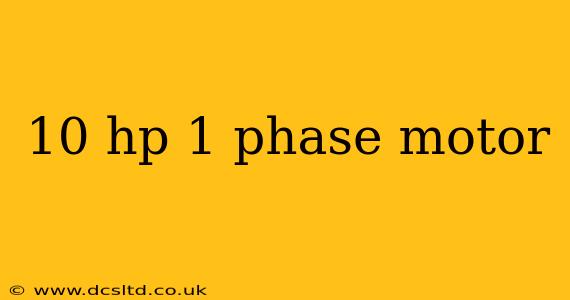Finding the right motor for your application can be a daunting task, especially when dealing with higher horsepower ratings like 10 HP in a single-phase configuration. This guide delves into the specifics of 10 HP 1-phase motors, addressing common questions and providing essential information for informed decision-making.
What are the applications for a 10 HP 1-phase motor?
10 HP 1-phase motors are relatively powerful and find use in various demanding applications where three-phase power isn't readily available. Common applications include:
- Heavy-duty stationary equipment: This includes large compressors, industrial pumps (like those used in water well systems or irrigation), and some woodworking machinery.
- Agricultural machinery: Certain farming equipment, such as grain augers or larger feed mixers, might utilize a 10 HP 1-phase motor.
- Construction equipment (smaller scale): While larger construction sites typically use three-phase power, smaller operations might employ a 10 HP 1-phase motor for specific tasks.
What are the advantages and disadvantages of using a 10 HP 1-phase motor?
Advantages:
- Simplicity of Installation: Single-phase power is readily available in most locations, eliminating the need for complex three-phase wiring.
- Cost-effectiveness (potentially): In situations where three-phase power isn't already installed, the cost of installing a single-phase system might be lower than upgrading to three-phase. However, the motor itself may be more expensive than a comparable three-phase motor.
Disadvantages:
- Higher Running Costs: Single-phase motors are generally less efficient than their three-phase counterparts, leading to higher energy consumption and operating costs.
- Limited Availability: Finding a 10 HP single-phase motor might be more challenging than finding a three-phase motor of the same power rating. Availability varies greatly depending on your geographic location.
- Potential for Overheating: The higher starting current of a single-phase motor can contribute to overheating, especially under heavy loads.
Are 10 HP 1-phase motors more expensive than 3-phase motors?
Generally, yes. The complexity of the design needed to achieve the same power output from a single-phase system, compared to a three-phase system, leads to higher manufacturing costs. Furthermore, lower demand for high-horsepower single-phase motors can also contribute to higher pricing.
What type of capacitor is needed for a 10 HP 1-phase motor?
A 10 HP 1-phase motor typically requires a permanent capacitor and possibly an additional start capacitor. The specific capacitor requirements will vary based on the motor's design and manufacturer. It is crucial to consult the motor's specifications or the manufacturer's instructions to determine the appropriate capacitor type, size, and connection method. Incorrect capacitor selection can lead to motor damage or failure.
What is the starting torque of a 10 HP 1-phase motor?
The starting torque of a 10 HP single-phase motor varies significantly based on the motor's design (split-phase, capacitor-start, capacitor-run, etc.) and manufacturer. Generally, single-phase motors have lower starting torque compared to three-phase motors of the same power rating. To determine the exact starting torque for a specific motor model, refer to the manufacturer's specifications.
How much current does a 10 HP 1-phase motor draw?
The current draw of a 10 HP 1-phase motor depends on several factors, including the motor's design, load, and voltage. Consult the motor's nameplate for the full-load current (FLA). Keep in mind that the starting current will be significantly higher than the FLA. It's crucial to ensure your electrical system can handle this high starting current.
How to choose the right 10 HP 1-phase motor for your needs?
Choosing the correct motor involves careful consideration of several factors:
- Application requirements: Determine the specific load characteristics, duty cycle, and operating conditions.
- Motor type: Select an appropriate motor type based on your needs (e.g., capacitor-start, capacitor-run).
- Voltage and frequency: Ensure compatibility with your power supply.
- Enclosure type: Choose an enclosure that provides adequate protection for the operating environment.
- Manufacturer's specifications: Always consult the manufacturer's data sheet to verify that the motor meets your requirements.
This guide provides a solid foundation for understanding 10 HP 1-phase motors. Remember that consulting with an experienced electrician or motor specialist is always advisable for complex installations or critical applications. Improper installation or use of such a powerful motor can lead to serious safety hazards.
